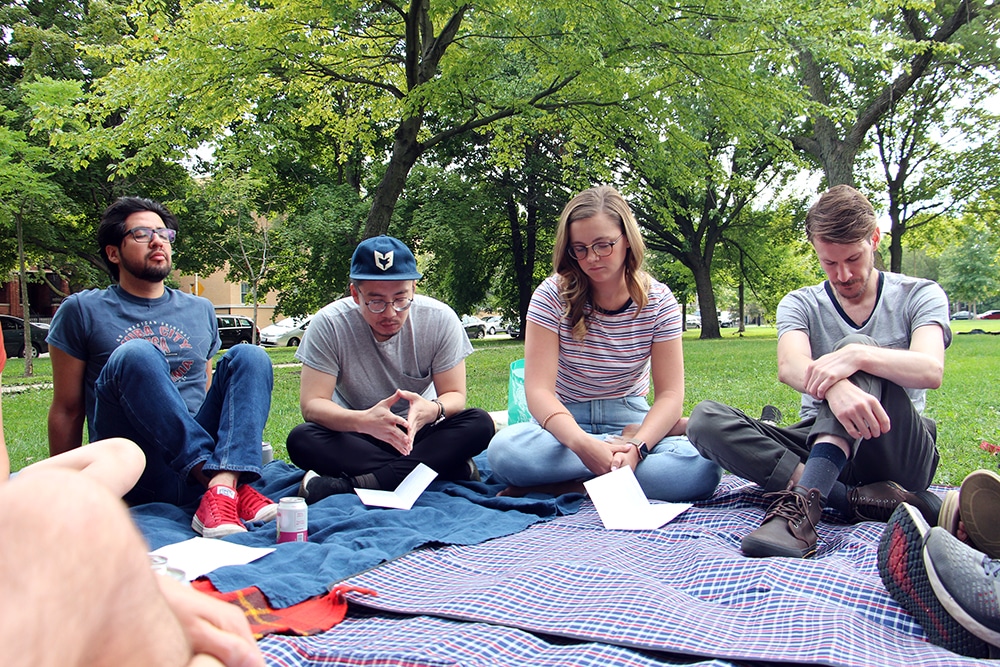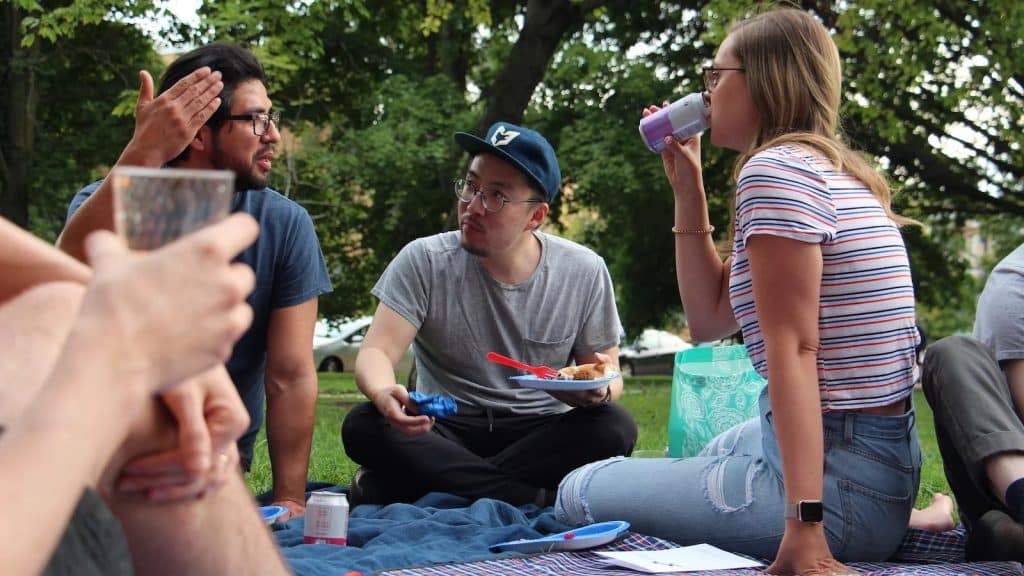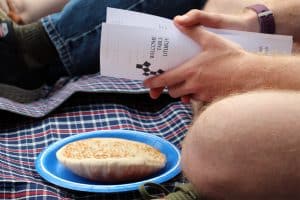

Pastor Tim Kim (center), members and guests of Root & Branch Church gather for a “dinner church” service Aug. 25, 2019, in Palmer Square Park in Chicago. RNS photo by Emily McFarlan Miller
CHICAGO (RNS) — On a near-perfect late summer evening, about a dozen people gathered on a picnic blanket in Chicago’s Palmer Square Park, spread between kids playing on playground equipment and young adults throwing a Frisbee disc on the lawn.
Accompanied by the crunch of joggers’ footsteps on the gravel path circling the narrow strip of green in the city’s trendy Logan Square neighborhood and the rumbling of a passing El train, one of the picnickers took a piece of pita bread and broke it in half.

Members of Root & Branch Church gather for a “dinner church” service Sunday evening, Aug. 25, 2019, in Palmer Square Park in Chicago. RNS photo by Emily McFarlan Miller
“This is our body,” he said, passing it to the person sitting next to him. Each person repeated the gesture before digging into a spread of food from a nearby restaurant.
This gathering wasn’t just another group of friends soaking up the last days of summer outside.
It was church.
Root & Branch Church calls this service the Welcome Table. It’s part of a growing trend of dinner churches popping up across the country in churches in a number of denominations, conservative and progressive, urban and rural and everything in between.
The dinner church movement sees gathering together for a meal itself as worship, rather than just another church potluck after worship.
“It’s also really important to recognize that dinner churches are not a fundamentally new thing, this is not just like the latest cool iteration of church, and that eating together has been central to the church for the entirety of the church’s life,” said Kendall Vanderslice, author of “We Will Feast: Rethinking Dinner, Worship, and the Community of God.”
Food and faith have gone together since God formed humans from the soil to enjoy all God made, according to Vanderslice.
For Christians, the two also echo the Last Supper that Jesus shared with his disciples and the example of the early church.
“The story of Jesus’ ministry is a ministry that takes place through meals,” she said. “It’s not just about sustenance, it’s about delight and it’s about joy. And it’s about forming community.”
Still, there are a number of reasons Vanderslice believes the dinner church movement is growing now, particularly among millennials craving relationships and meaning. For one, she said, it fills a “profound need for community.”
“I think really that loneliness pervades every generation, and I think that loneliness is in part because the church has lost its focus on community,” she said.
Vanderslice began studying dinner churches in 2015 while in a graduate program in food studies at Boston University.
She spent three months attending Thursday night dinner church gatherings at Simple Church outside Boston. By the time she finished writing her thesis, she’d learned about 30 similar gatherings.
Pretty soon, she said, she lost count of the dinner churches starting every week, each unique to the needs of a specific community and context.
“I think there’s no one-size-fits-all model that can be sort of plopped down into any context and work,” she said.

Members of Root & Branch Church pray during a “dinner church” service Sunday evening, Aug. 25, 2019, in Palmer Square Park in Chicago. RNS photo by Emily McFarlan Miller
Some dinner churches meet in restaurants. Others in gardens, growing the food they’ll eat together.
Nearly all the dinner churches Vanderslice has encountered were inspired by St. Lydia’s in Brooklyn, a decade-old congregation in the Evangelical Lutheran Church in America.
The Rev. Emily Scott founded the church after noticing how rarely New Yorkers gathered for a home-cooked meal, according to the Rev. Elsa Marty, who now pastors at St. Lydia’s.
Believing that’s where connections are made, Scott started structuring services around a meal.
First, St. Lydia’s met in an apartment. Then, it moved to an ELCA church building and a Zen center, before eventually landing in a storefront.
Along the way, the church has shared its experience with other congregations around the country.
“It’s just lovely to see how it’s blossoming in many different places around the country,” Marty said.
These days, she said, St. Lydia’s twice-weekly dinner church services stretch over two hours. Those gatherings include singing and chanting, time for conversation “built into the heart of the service” over dinner, a brief sermon and responses from participants.
They end with everybody cleaning up together.
The church also has added monthly waffle church services geared toward families with children and some contemplative prayer services, according to the pastor.
Some people come to dinner church because they are looking for something different from the church services they attended growing up. Others are interested in a service that engages all their senses. And some, Marty said, are attracted by the opportunity to be an active participant in the service.
“You can’t sit in the back pew. … It’s a really engaged kind of service,” Marty said. “I think especially for young millennials that are so into their screens, this is real human interaction.”

Members of Root & Branch Church use their phones during part of a “dinner church” service Sunday evening, Aug. 25, 2019, in Palmer Square Park in Chicago. RNS photo by Emily McFarlan Miller
Chicago’s Root & Branch, part of the Christian Church Disciples of Christ denomination, was inspired by St. Lydia’s when it started about six years ago, according to Pastor Tim Kim.
As the congregation began to grow, Kim said, the church needed to find ways to make sure people still were able to share openly and get to know one another.
It began alternating what it calls “All Together Church” in a community art space with Welcome Table services every other week, breaking into smaller groups and meeting in people’s homes.
Kim said the congregation is composed of millennials who “often describe ourselves as church outsiders — people who wouldn’t feel like they fit or at home or belong in other church settings.”
Some grew up in churches that taught harmful theologies or that hurt or rejected them for who they were, he said. Some just aren’t drawn to the structure or culture of more traditional church services. And some don’t necessarily call themselves Christian, but they’re interested in exploring big questions in community.
To Kim, God is like a “mosaic of people.”
“We see pieces of God in every face that we encounter, and that mosaic makes up a whole of who God is to us,” he said.

Lauran Quist listens to the discussion during Root & Branch Church’s “dinner church” service Aug. 25, 2019, in Palmer Square Park in Chicago. RNS photo by Emily McFarlan Miller
Lauran Quist, who attended the gathering Sunday (Aug. 25) in Palmer Square Park, grew up going to church. But she didn’t always feel at home.
The first time Quist attended a service at Root & Branch, she said, things were different. There was wine and food and no one was a stranger.
And she liked that all were drawn into a discussion, rather than listening to a sermon.
“When somebody is telling you how to have a faith, you may feel some guilt or some need to be like that, but it’s really not going to be authentic and it’s not going to be able to take real root in your life,” Quist said.
Dorian Sitkoski, who has attended Root & Branch for five years, said those discussions appealed to her, too, because it “acknowledges that not everything is easy to understand.”
“Sometimes you need to process through them and explore it and let your understanding evolve over time,” she said.
Over dinner on Sunday, the group from Root & Branch chatted about upcoming travel, about apartment life, about their jobs.
Later, group members pulled out their smartphones to read a Gospel passage from their screens about one of Jesus’ healing miracles and shared their responses. Finally, they passed around a bottle of wine and filled their cups, bookending the service with the elements of Communion.
Before the meal and discussion began, however, they prayed.
“For friends in a city where many walk alone, we give thanks.”






